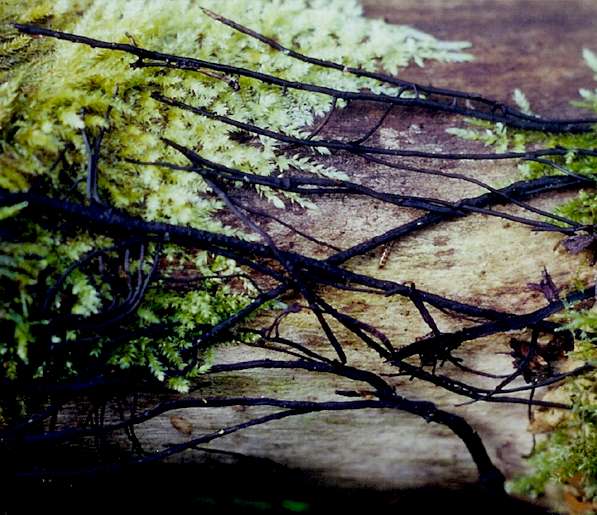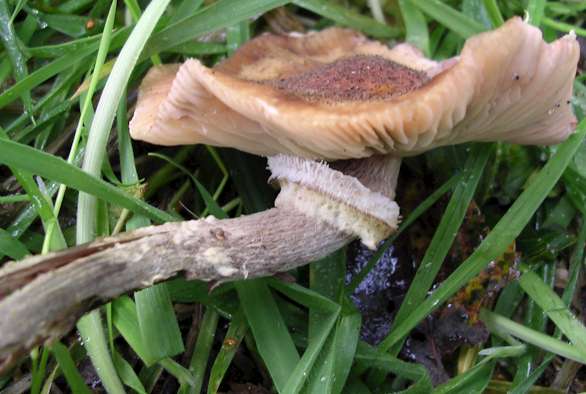..
FOCUS TOPIC - MAJOR TREE PATHOGENS: ARMILLARIA The fungus Armillaria mellea (also known as Armillariella mellea or Armillariella elegans) is one of the most common root-rotting fungi, but seems to exist in several forms, some of which have now been formally described as separate species (e.g. Armillaria mellea, A, gallica, A. ostoyea and A. tabescens). There is also evidence that strains of these fungi can differ in pathogenicity, so in some respects "Armillaria" could be regarded as a species complex, and the name Armillaria will be used in the rest of this account. Armillaria characteristically attacks trees at or below soil level and then produces extensive fans of hyphae that spread upwards under the bark, causing damage by destroying the young woody tissues, and then progressively rotting the wood, causing a "white rot" (see Wood-rot Fungi). The infection spreads from tree to tree through root-to-root contacts, and also spreads through soil by producing an extensive network of hyphae that are aggregated into thick, black mycelial structures termed rhizomorphs (Figure 1 below). The rhizomorphs can spread beneath the soil surface for at least 3 metres, because they are provided with nutrients translocated from an infected tree, and are often also seen beneath the bark of dead or dying trees. The most pathogenic strains can cause substantial damage by rotting the root systems of trees, especially if the trees are stressed or start to senesce through damage to the root systems, advancing age, or simultaneous attack by other tree-rot pathogens.
Clusters of fruitbodies of A. mellea (commonly termed the "Honey Fungus" or the "Bootlace Fungus") are produced in abundance at the bases of infected trees, fallen logs or the stumps of felled trees. The fruitbodies (basidiomes) are variable but often have a honey-coloured cap about 7 - 10 cm. diameter, with darker scales at the centre. (Fig. 2), a conspicuous ring (Fig. 3) and a darker base to the stipe (stem).
Fig. 2. A typical cluster of Armillaria fruitbodies, growing from the base of a tree stump. [© Jim Deacon]
It is entirely feasible that Armillaria could have contributed to the death of this tree or could even have initiated the infection. Armillaria is a potentially dangerous pathogen that, once established in a site is virtually impossible to eradicate. It is commonly regarded as one of the most significant root-rot pathogens of trees. It can rapidly kill groups of young conifers that are transplanted into clear-felled forest sites. When it invades fallen logs or the stumps and major roots of felled trees it causes an intensive white rot, in which the woody tissues are degraded by reactive oxygen species such as hydrogen peroxide, manganese peroxidase and ligninase. This oxidative digestion of the woody tissues has been coined "enzymatic combustion" (see Chapter 11). It is interesting to note that A. mellea can also be a problem in sites where native bushland has been clear-felled in parts of the sub-tropical region of South Africa, to establish banana plantations. If the land is immediately planted with banana plants these can be killed by Armillaria. But the basal stem and corm tissues of bananas cannot support the growth of Armillaria for more than one or two years, so the inoculum level soon declines and bananas can then be grown successfully, with no further disease. This indicates the relatively non-specific pathogenic nature of A. mellea. Postscript to Armillaria - The Humongous Fungus! In April 1992, Smith, Bruhn & Anderson published an article in the journal Nature, reporting that the fungus Armillaria gallica is among the largest and oldest living organisms. That research was based on a study of a large and genetically uniform clone of A. gallica, conservatively estimated to be at least 1500 years old and to weigh at least 9,700 kilograms. There were subsequent reports of even larger "individuals", culminating in August 2000 with a report from the United States Forest Service that an even larger fungus, Armillaria ostoyae, had been found in the Blue Mountains region of Eastern Oregon. This fungus reaches nearly 900 hectares in extent and is estimated to be more than 2,400 years old. In largely undisturbed habitats such as native forests it is perhaps not surprising that such large clones exist, and it would not be surprising if even larger clones were discovered. But the fascinating story of the Humongous Fungus also raises interesting questions about "how do we define an organism"?. You can read more about this at Tom Volk's website. |



